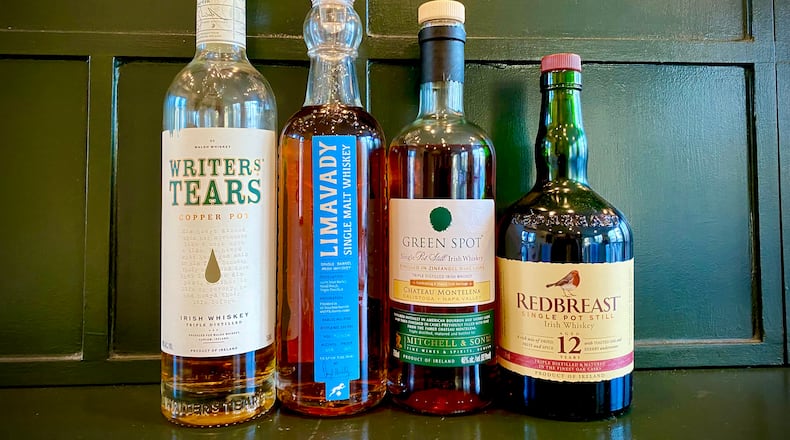As St. Patrick’s Day approaches, we would like to offer high-quality Irish whiskey as an alternative to the likes of green beer. Once the world’s best-selling spirit, Irish whiskey saw a collapse in the early 20th century, but now is on a comeback, growing faster than any other spirit.
Less bold than bourbon and less polarizing than peated Scotch, Irish whiskey offers a bright, beautifully balanced drinking experience.
It has been around for about 1,000 years, but the oldest recorded documents date back to 1405. It still is up for debate whether Ireland or Scotland created the cereal grain distillate we now call whiskey, but, by the mid-1800s, Ireland was exporting whiskey to Britain and America.
Irish whiskey saw a steady decline after Ireland’s war for independence in 1919 resulted in exports being blocked, followed by Prohibition in the U.S. By 1966, only two distilleries remained: Bushmill’s in the north and Midleton’s in the south, both owned by Irish Distillers.
The whiskey’s resurgence began in the 1980s, when Irish Distillers was taken over by global company Pernod-Ricard, which heavily marketed its Jameson brand.
There are now at least 33 Irish whiskey distilleries in operation, and about a dozen more in the works.
Of course, prices have risen, as well. Even so, the price-to-quality ratio is better than some Scotch and bourbon counterparts.
All of the selections below are triple distilled. Three of the four labels claim to use a single-pot still, a production method said to impart more flavor in the spirit. The fourth, Limavady, claims to be the first single-barrel Irish whiskey.
- Writer’s Tears Copper Pot: Established by Bernard and Rosemary Walsh in 1999, Writer’s Tears has a line of eight whiskey expressions, including cask-strength and Japanese-cask, but Copper Pot was their first. This whiskey has a lot of apple and ginger on the palate, with a hint of cocoa as it finishes.
- Limavady: This is the revival of a brand that dates to 1750, and the distiller, Darryl McNally, can trace lineage to the original owners. Made possible by a collaboration with the renowned WhistlePig whiskey folks in Vermont, Limavady has the taste of fig and prune up front, giving way to baking spices on the finish.
- Green Spot Chateau Montelena zinfandel barrel finish: Midleton Distillery has been providing whiskey to Mitchell & Son, Dublin’s wine merchants and whiskey bonders (who purchase whiskey, and age it), since 1805. Its newest iteration is Green Spot whiskey, finished in wine casks that previously held zinfandel from Chateau Montelena, a California winery with Irish heritage. Ripe pear and maraschino cherry (from the influence of the wine cask) hit the nose, while spicy almond and toasted barrel notes delight the palate.
- Redbreast 12: Also produced at the Midleton distillery, Redbreast has been around since 1912. The 80-proof whiskey is aged in a combination of spent bourbon and sherry casks for at least 12 years. Offering notes of dried fruits and brown sugar that are reminiscent of fruit cake, this fine whiskey is one to savor neat.
Sign up for the AJC Food and Dining Newsletter
Read more stories like this by liking Atlanta Restaurant Scene on Facebook, following @ATLDiningNews on Twitter and @ajcdining on Instagram.
About the Author
The Latest
Featured


